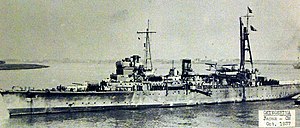
Back Okinoshima (Schiff, 1936) German Okinoshima (1936) Spanish Okinoshima (mouilleur de mines) French Okinoshima (posamine) Italian 沖島 (敷設艦) Japanese Окиносима (минный заградитель) Russian Окіносіма (загороджувач) Ukrainian
 Okinoshima in 1937
| |
| History | |
|---|---|
| Name | Okinoshima |
| Namesake | Okinoshima Island |
| Ordered | fiscal 1931 |
| Builder | Harima Shipyards |
| Laid down | 27 September 1934 |
| Launched | 24 November 1935 |
| Commissioned | 30 September 1936 |
| Stricken | 25 May 1942 |
| Fate | Sunk after being torpedoed by USS S-42, 12 May 1942 |
| General characteristics | |
| Type | Minelayer |
| Displacement | 4,290 long tons (4,359 t) (standard) |
| Length | |
| Beam | 15.74 m (51 ft 8 in) |
| Draught | 5.49 m (18 ft) |
| Installed power | |
| Propulsion | 2 shafts; 2 geared steam turbines |
| Speed | 20 knots (37 km/h; 23 mph) |
| Range | 9,000 nmi (17,000 km; 10,000 mi) at 10 knots (19 km/h; 12 mph) |
| Complement | 445 |
| Armament |
|
| Aircraft carried | 1 × Kawanishi E7K seaplane |
| Aviation facilities | 1 aircraft catapult |
Okinoshima (沖島) was a large minelayer of the Imperial Japanese Navy (IJN), which was in service during the early stages of World War II. She was named after the Okinoshima Island in the Sea of Japan. She was the largest purpose-built minelayer in the IJN and the first Japanese minelayer to be equipped with a reconnaissance seaplane.